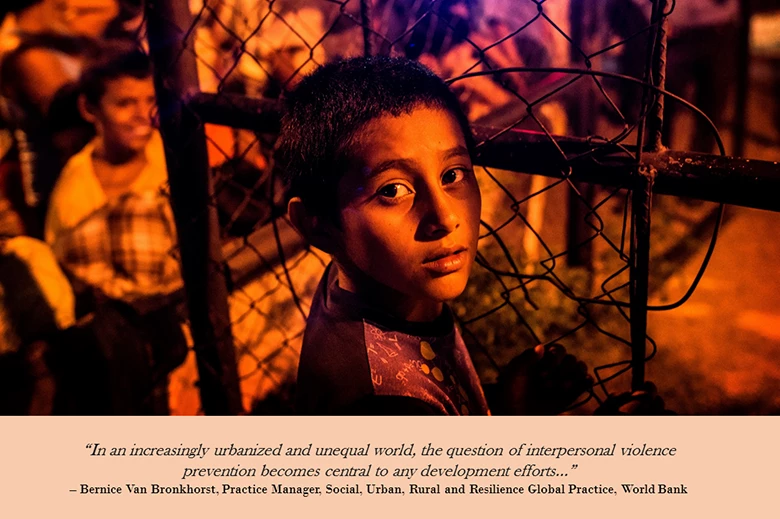Today, October 2nd, is the International Day of Non-Violence , a day that reminds us of the serious development challenge of interpersonal violence.
Violence is a multi-causal phenomenon. Therefore, preventing violence requires a multi-sectoral approach. What does this concretely mean? It means that to prevent violence in a sustainable way, we need to address its multiple causes at the same time. It also means to move away from a punitive perspective solely focused on the criminal justice system and acknowledge the shared responsibility for violence prevention and the need for different sectors and government agencies to contribute to solving the issue.
Over the last two decades, the World Bank has joined international efforts to create a coalition of like-minded development partners to prioritize violence prevention in the development agenda. Today, let’s hear from development practitioners from across the World Bank on their reflections of the critical role of violence prevention in ending extreme poverty and boosting shared prosperity toward the Sustainable Development Goals:
Education

“Schools can be mirrors of their society, perpetuating engrained patterns of injustice and violence. But schools can also be transformative. Making education systems more inclusive, equitable and peaceful is a direct avenue to prevent violence and foster respect for diversity, a bridge across social divisions.”
– Luis Benveniste, Director, Education Global Practice, World Bank
Urban Development

“In an increasingly urbanized and unequal world, the question of interpersonal violence prevention becomes central to any development efforts. Fifteen years ago, the [World] Bank pioneered in mainstreaming violence prevention in urban development/slum upgrading operations in Honduras, Jamaica, and Brazil. By combining situational prevention, using methodologies such as Crime Prevention Through Environmental Design (CPTED), with social interventions focused on enhancing social capital, we have created positive synergies and enhanced the effectiveness and sustainability of the projects we supported. With these examples in mind, we now need to take a step further and multiply these good practices whenever we work in cities who suffer from high rates of violence and crime. Let’s work together to ensure we address the most pressing and relevant issues that affect the daily life of so many citizens in our client countries.”
– Bernice Van Bronkhorst, Practice Manager, Social, Urban, Rural and Resilience Global Practice, World Bank
Governance

Sources used: WDR 2017, page 130 and 133; Colombia mobile justice services Impact Evaluation TOR; Achieving results against the odds in violent contexts"Violence perpetuates poverty and social marginalization everywhere in the world. There can be no good governance in the presence of crime and violence, conflict and fragility. As the 2017 World Development Report showed, ‘institutions that share power, redistribute wealth, settle disputes, and sanction and deter violence have been found to reduce violence and increase security in the short term, along with changes in norms and attitudes towards violence over the long term.’ In development projects, governance is a critical ingredient and sometimes-invisible hand advancing multi-sectoral interventions. The challenges are enormous, yet every day we witness an exciting innovation or break-though. We developed fit-for-purpose models of service delivery in violent contexts such as Afghanistan and we supported Colombia’s efforts to increase access to justice through mobile services, to name just two. Everyone needs to join the fight to end violence, end poverty in the world!"
– Jim Brumby, Director, Governance Global Practice, World Bank
Health, Nutrition, and Population

“Since violence in its many forms—interpersonal, self-directed and collective—often leads to physical and mental impairment, disability, and premature death, it is a major public health issue. Interpersonal violence and self-harm are among the top 25 causes of global years of life lost, and WHO estimates that about 500,000 deaths occurred worldwide in 2012 as a result of homicide alone. What to do? While violence prevention is a complex challenge, given its broad social determinants, experience from around the world shows that effective solutions are possible. Political commitment and coordinated multi-sectoral action should be informed by systematic collection and utilization of data and information. If this is not done, countries are destined to live perhaps not “100 years in solitude” but to be fragile and vulnerable. Their development prospects may well continue to be undermined by high human capital and economic losses, as well as by the erosion of social capital due to fear among the population that perhaps the next victim of violence will be a loved one.”
– Patricio Marquez, Lead Public Health Specialist, Health, Nutrition and Population Global Practice, World Bank
Transport

“Violence prevention is fundamental to reducing the risks faced by transport users and operators, such as robbery, physical assault, homicide, sexual and racial harassment, and even terrorism. Violence in transport constitutes a barrier to public transport use, limits access to better jobs and services, and can also deter people from working in transport operations. Both situations undermine the potential of the transport sector to catalyze development and to connect people to opportunity.”
– Felipe Targa, Senior Urban Transport Specialist, and Karla Dominguez, Gender Specialist, Transport and ICT Global Practice, World Bank


Join the Conversation